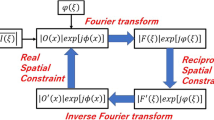Abstract
The split-screen imaging technique, in which the field of view of a single video/still camera is divided into two (or more) regions, is one of the techniques for observing, using a single camera, liquid droplets, bubbles or particles translating in another fluid from two (or more) different directions. A drawback of the split-screen imaging technique is that it generally requires a longer optical path than the ordinary multi-camera technique that allots each view axis to each of two (or more) synchronized cameras. This study presents an optical arrangement that minimizes the optical path for the two-directional split-screen imaging so as to allow the use of a camera lens with a short working distance. Its modification configured for the three-directional split-screen imaging of translating bubbles or drops is also presented.
Graphical Abstract













Similar content being viewed by others
References
Bardet PM, Peterson PF, Savaş Ö (2010) Split-screen single-camera stereoscopic PIV application to a turbulent confined swirling layer with free surface. Exp Fluids 49:513–524. doi:10.1007/s00348-010-0823-2
Brücker C (2000) 3-D measurements of bubble motion and wake structure in two-phase flows using 3-D scanning particle-image-velocimetry (3-D SPIV) and stereo-imaging. In: Laser techniques applied to fluid mechanics, pp 621–635
Celata GP, Cumo M, D’Annibale F, Di Marco P, Tomiyama A, Zovini C (2006) Effect of gas injection mode and purity of liquid on bubble rising in two-component systems. Exp Therm Fluid Sci 31:37–53. doi:10.1016/j.expthermflusci.2005.08.006
Clift R, Grace JR, Weber ME (1978) Bubbles drops and particles. Academic Press, New York, pp 35–38
Drescher K, Leptos KC, Goldstein RE (2009) How to track protists in three dimensions. Rev Sci Instrum 80:014301. doi:10.1063/1.3053242
Duan FJ, Yan L, Zhang HT, Lv XM (2006) Research on three-dimensional measurement system of bubble behavior in two-phase gas–liquid flow. J Phys Conf Ser 48:571–575. doi:10.1088/1742-6596/48/1/107
Ehara N, Nojima K, Mori YH (1993) Visualization study of evaporation of single n-pentane drops in water. Exp Fluids 14:97–103. doi:10.1007/BF00196993
Grant I, Zhao Y, Smith GH, Stewart JN (1995) Split-screen, single-camera, laser-matrix, stereogrammetry instrument for topographical water wave measurements. Appl Opt 34:3806–3809. doi:10.1364/AO.34.003806
Haam SJ, Brodkey RS (2000) Motions of dispersed beads obtained by particle tracking velocimetry measurements part II. Int J Multiph Flow 26:1419–1438. doi:10.1016/S0301-9322(99)00095-6
Nojima K, Mori YH (1994) Clathrate hydrate formation on single refrigerant vapor bubbles released into water: an observational study. In: Hewitt GF (ed) Heat transfer, vol 3. Institution of Chemical Engineers, Rugby, UK, pp 377–382
Putze T, Raguse K, Maas H-G (2007) Configuration of multi mirror systems for single high speed camera based 3D motion analysis. In: Beraldin J-A, Remondino F, Shortis MR (eds) Proceedings of SPIE-IS&T electronic imaging, SPIE, vol 6491, Paper no. 64910L
Raffel M, Willert C, Kompenhans J (1998) Particle image velocimetry. Springer, Berlin, pp 217–221
Sato H, Kaji N, Mochizuki T, Mori YH (2006) Behavior of oblately deformed droplets in an immiscible dielectric liquid under a steady and uniform electric field. Phys Fluids 18:127101. doi:10.1063/1.2399753
Takamasa T, Miyoshi N (1993) Measurements of bubble interface configurations in vertical bubbly flow using image-processing method. Nihon Kikaigakkai Ronbunshu Ser B 59:2403–2409 (in Japanese)
Takamasa T, Watari M (1996) Measurements of bubble interfacial configurations in vertical bubbly flow using stereo image-processing method (SIM) In: FED, vol 239. Fluids engineering division conference, vol 4. ASME, New York, pp 175–180
Yamamoto Y, Abe Y, Fujiwara A, Hasegawa K, Aoki K (2008) Internal flow of acoustically levitated droplet. Microgravity Sci Technol 20:277–280. doi:10.1007/s12217-008-9070-z
Acknowledgments
This study was supported by a Grant-in-Aid for Scientific Research (C) from the Japan Society for the Promotion of Science (Grant no. 21560202) and Financial Assistance for Scientific Research Projects from the Suzuki Foundation. We thank Prof. Noel T. Clemens, The University of Texas at Austin, for his helpful comment on the literature about the split-screen imaging technique. We also thank the reviewers of this manuscript for their useful comments.
Author information
Authors and Affiliations
Corresponding author
Electronic supplementary material
Below is the link to the electronic supplementary material.
Rights and permissions
About this article
Cite this article
Mochizuki, T., Sato, H. & Mori, Y.H. Multi-angle observation scheme for bubbles and droplets. J Vis 15, 125–137 (2012). https://doi.org/10.1007/s12650-011-0120-z
Received:
Accepted:
Published:
Issue Date:
DOI: https://doi.org/10.1007/s12650-011-0120-z




